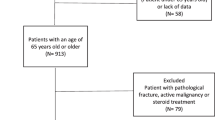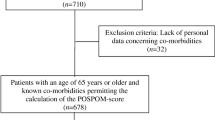Abstract
Hip fractures are a significant cause of mortality and morbidity in the elderly. It is important to identify factors that predict an increased mortality following hip fracture. The aim of this study was to identify significant predictors of mortality at 6 and 12 months following hip fractures. Three hundred patients above the age of 65 were identified who were admitted in to the hospital with fracture neck of femur. Two hundred and seventy-four patients were operated and were included into the study. Variables collected were age, gender, significant comorbidities, admission albumin level and admission total lymphocyte count (TLC). Admission time and subsequent time to surgery were also analysed. Our study showed that albumin and TLC were found to be the only clearly significant mortality predictors at 12 months and a delay of up to 4 days to surgery does not significantly increase the mortality at 12 months.
Similar content being viewed by others
References
Papadimitropoulos E, Coyte PC, Josse R, Greenwood CE (1997) Current and projected rates of hip fracture in Canada. CMAJ 157:1357–1363
Cooper C, Campion G, Melton LJ (1992) Hip fractures in the elderly: a world-wide projection. Osteoporos Int 2:285–289
Gulberg B, Johnell O, Kanis JA (1997) World-wide projections for hip fracture. Osteoporos Int 7:407–413
No authors listed. http//www.nhfd.co.uk Blue book 2007. http://www.ccad.org.uk/nhfd.nsf/Preliminary_National_Report.pdf. Accessed 5th August 2013
Holt G, Smith R, Duncan K, Finlayson DF, Gregori A (2008) Early mortality after surgical fixation of hip fractures in the elderly an analysis of data from the Scottish hip fracture audit. J Bone Joint Surg (Br) 90(10):1357–1363
Lefraivre KA, Macadam SA, Davidson J, Gandhi R, Chan H, Broekhuyse HM (2009) Length of stay, mortality, morbidity and delay to surgery in hip fracture. J Bone Joint Surg (Br) 91:922–927
Kenzora JE, McCarthy RE, Lowell JD, Sledge CB (1984) Hip fracture mortality: relation to age, treatment, preoperative illness, time of surgery and complication. Clin Orthop 186:45–56
Dahl E (1980) Mortality and life expectancy after hip fractures. Acta Orthop Scand 51:163–170
Foster MR, Heppenstall RB, Friedenberg ZB, Hozack WJ (1990) A prospective assessment of nutritional status and complications in patients with fractures of the hip. J Orthop Trauma 4:49–57
Symeonidis PD, Clark D (2007) Assessment of malnutrition in hip fracture patients: effects on surgical delay, hospital stay and mortality. Acta Orthop Belg 72:420–427
Hanger HC, Smart EJ, Merrilees MJ, Frampton CM (1999) The prevalence of malnutrition in elderly hip fracture patients. N Z Med J 112:88–90
Klotzbuecher CM, Ross PD, Landsman PB et al (2000) Patients with prior fractures have an increased risk of future fractures: a summary of literature and statistical synthesis. J Bone Miner Res 15(4):721–739
Siegmeth AW, Gurusamy K, Parker MJ (2005). Delay to surgery prolongs hospital stay in patients with fractures of the proximal femur. J Bone Joint Surg (Br) 87-B(8):1123–1126
Moran CG, Wenn RT, Sikand M, Taylor AM (2005) Early mortality after hip fracture: is delay before surgery important? J Bone Joint Surg (Am) 87A(3):483–489
van Zeeland ML, Genovesi IP, Mulder JW, Strating PR, Glas AS, Engel AF (2011) POSSUM predicts hospital mortality and long-term survival in patients with hip fractures. J Trauma 70(4):E67–E72
Maxwell MJ, Moran CG, Moppett IK (2008) Development and validation of a preoperative scoring system to predict 30 day mortality in patients undergoing hip fracture surgery. Br J Anaest 101(4):511–517
Dawe EJ, Lindisfarne E, Singh T, McFadyen I, Stott P (2013) Sernbo score predicts survival after intracapsular hip fracture in the elderly. Ann R Coll Surg Engl 95(1):29–33
Al-Ani AN, Samuelsson B, Tidermar J et al (2008) Early operation on patients with a hip fracture improved the ability to return to independent living. JBJS (Am) 90:1436–1442
Sernbo I, Johnell O (1993) Consequences of a hip fracture: a prospective study over 1 year. Osteoporos Int 3:148–153
British Orthopaedic Association (2007) The care of patients with fragility fracture. Br Orthop Ass. http://www.boa.ac.uk. Accessed 5 August 2013
Lee HP, Chang YY, Jean YH, Wang HC (2009) Importance of serum albumin level in the preoperative tests conducted in elderly patients with hip fracture. Injury 40(7):756–759
Koval KJ, Maurer SG, Su ET, Aharonoff GB, Zuckerman JD (1999) The effects of nutritional status on outcome after hip fracture. J Orthop Trauma 13(3):164–169
Jensen JS (1984) Determining factors for the mortality following hip fractures. Injury 15:411–414
Lumbers M, New SA, Gibson S, Murphy MC (2001) Nutritional status in elderly female hip fracture patients: comparison with an age-matched home living group attending day centers. Br J Nutr 85:733–740
Maffuli N, Dougall TW, Brown MT, Golden MH (1999) Nutritional differences in patients with proximal femoral fractures. Age Ageing 28:458–462
Patterson BM, Cornell CN, Carbone B, Levine B, Chapman D (1992) Protein depletion and metabolic stress in elderly patients who have a fracture of the hip. J Bone Joint Surg (Am) 74:251–260
Ponzer S, Tidemark J, Brismar K et al (1999) Nutritional status: insulin-like growth factor-1 and quality of life in elderly women with hip fractures. Clin Nutr 18:241–246
Beregeron E, Lavoie A, Moore L et al (2006) Is the delay to surgery for isolated hip fracture predictive of outcome in efficient systems? J Trauma 60:753–757
National Clinical Guideline Centre (2011) Hip fracture. NICE, London. Accessed 5 August 2013
Kieffer WK, Rennie CS, Gandhe AJ (2013) Preoperative albumin as a predictor of one-year mortality in patients with fractured neck of femur. Ann R Coll Surg Engl 95(1):26–28
Conflict of interest
We, authors of this article, certify that there is no actual or potential conflict of interest in relation to this article.
Author information
Authors and Affiliations
Corresponding author
Rights and permissions
About this article
Cite this article
Kumar, V., Alva, A., Akkena, S. et al. Are albumin and total lymphocyte count significant and reliable predictors of mortality in fractured neck of femur patients?. Eur J Orthop Surg Traumatol 24, 1193–1196 (2014). https://doi.org/10.1007/s00590-013-1299-6
Received:
Accepted:
Published:
Issue Date:
DOI: https://doi.org/10.1007/s00590-013-1299-6




